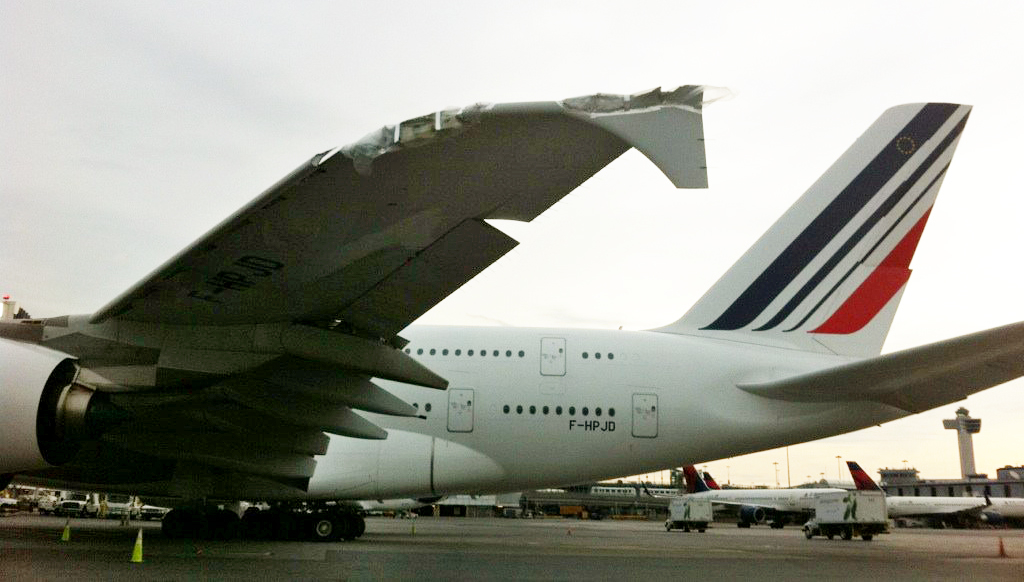
A damaged Airbus A380 belonging to Air France sits on the runway at John F. Kennedy International Airport, Tuesday, April 12, 2011 in New York. The world’s largest passenger aircraft clipped a much smaller Bombardier CRJ700 on a wet tarmac at JFK on Monday, April 11. No one was injured. (AP Photo/NYCAviation)
Audience
- Sentiment: tragic
- Political Group: safety advocates
- Age Group: 30-60
- Gender: all genders
Overview
- Two small planes collided midair at Marana Regional Airport, resulting in the loss of two lives.
- The incident highlights concerns about aviation safety and the need for improved air traffic control measures.
- The community and aviation industry must learn from such tragedies to enhance safety protocols and prevent future accidents.
Midair Collision Tragedy at Marana Regional Airport
On a clear day in Marana, Arizona, tragedy unfolded in the skies over Marana Regional Airport, which is located just north of Tucson. On that fateful morning, two small planes collided, leading to not just one, but two lives lost—a heartbreaking reminder of how quickly normal life can change. Let’s take a closer look at what happened that morning, the implications of such an incident, and the importance of safety in aviation.
A Day Like Any Other
It was the morning of a typical day at Marana Regional Airport. The sun was shining, and the sky was clear, making for perfect flying weather. Pilots and passengers alike were excited to take to the skies. A Cessna 172S, known for its reliability and popularity among general aviation pilots, took off with two passengers onboard, flying with dreams of a serene journey. Meanwhile, its counterpart, a Lancair 360 MK II—an aircraft known for speed and performance—was also preparing for takeoff with its own crew of two. Everything seemed routine, but in the world of flying, routine can quickly turn into chaos.
The Collision
According to preliminary reports, both aircraft were in the airspace near runway 12. Imagine two cars at an intersection; they may look safe, but if one runs a red light, disaster can strike. In the case of the planes, it seems they approached the same space at the same time—an air traffic control nightmare. At around 8:25 AM local time, both planes collided midair. Eyewitnesses described seeing the Lancair spiral downward before crashing and erupting into flames on impact.
The fire from the wreckage must have been dreadful to behold, perhaps reminiscent of a scene from an action movie, but this was no Hollywood fantasy. This was a tragic reality for those on board and their families, and news of the collision quickly spread.
First Response and Investigation
Emergency response teams arrived on the scene quickly, but it was already too late for the passengers in the aircraft. The loss of life is a profound tragedy, as families were now left to deal with the aftermath of sudden grief. The National Transportation Safety Board (NTSB) was called in to investigate the situation, while the Federal Aviation Administration (FAA) reported the incident and began looking into the circumstances surrounding the collision.
Accidents like these are rare, especially with small aircraft, but they do happen, raising questions about safety measures and regulations. What could have been done differently? Could air traffic control have prevented the collision? These are crucial questions that need to be addressed to ensure that such a disaster doesn’t happen again.
A Concerning Trend in Aviation Safety
This tragic accident is part of a broader worry about the safety of air travel in the U.S. Over recent years, there have been several incidents involving small planes that have raised eyebrows among aviation safety advocates. While it is essential to acknowledge that flying is still one of the safest modes of transportation, any loss of life is a reminder that there is always room for improvement.
Calls for urgent funding to enhance air traffic control measures have picked up steam in the wake of several accidents. Air traffic controllers play a crucial role in keeping the skies safe, guiding pilots to their destinations while monitoring airspace. Advanced radar systems, comprehensive training, and effective communication with pilots are essential in preventing accidents.
Learning from Tragedies
As we reflect on what happened at Marana Regional Airport, it is vital to recognize the importance of learning from these tragedies. Aviation, despite its complexities, is designed around redundancy and safety measures—pilot training, pre-flight checks, and flight manuals are just the tip of the iceberg. Events like the collision at Marana remind us that authorities and industry leaders must continuously strive to improve safety protocols.
Each tragedy in aviation brings new lessons that can help shape future regulations and safety guidelines. For instance, after previous accidents, many airports and their associated air traffic control systems have made changes. Whether it is improved technology or revised procedures, these adaptations can help minimize risks.
Community Impact
The repercussions of the collision are far-reaching and impact not only the families of those involved but also the community within Marana and the broader aviation community. Every accident sends ripples through the fabric of communities, especially when it pertains to flying, which many people view with a mix of excitement and anxiety. Pilots earn their wings through rigorous training and share a commitment to safety.
Communities often rally together in times of loss, providing support to the families affected. Candlelight vigils and memorial services become focal points for grief and remembrance, showing that while individuals may fly solo in the skies, they are part of a larger community that supports each other through life’s turbulence.
Looking Forward
As tragedy struck at Marana Regional Airport, it became a sobering reminder of the responsibilities that come with flying. It raises questions about how we can learn from mistakes, how technology can be improved, and how important communication is among pilots and air traffic control. As our world becomes increasingly reliant on air travel, the need for stringent safety measures has never been more significant.
Every time a plane takes off, lives are at stake, not just in the aircraft but also on the ground. Safety should be the priority in every aspect of aviation, because it’s not just about getting from one place to another—it’s about making sure everyone aboard returns home safely.
So, as we look ahead and consider what can be done to prevent such incidents, we also invite you, dear readers, to share your thoughts. Have you experienced or witnessed a flying incident or have any thoughts on how aviation safety could be improved? What do you think should be the priorities for ensuring that air travel remains safe? Please leave a comment below!





